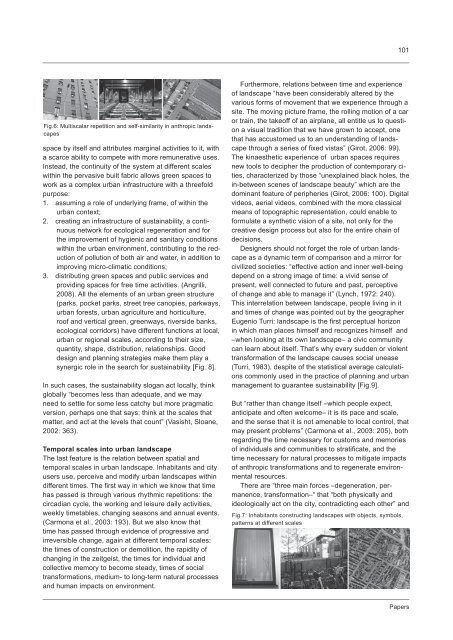Landscape – Great Idea! X-LArch III - Department für Raum ...
Landscape – Great Idea! X-LArch III - Department für Raum ...
Landscape – Great Idea! X-LArch III - Department für Raum ...
You also want an ePaper? Increase the reach of your titles
YUMPU automatically turns print PDFs into web optimized ePapers that Google loves.
101<br />
Fig.6: Multiscalar repetition and self-similarity in anthropic landscapes<br />
space by itself and attributes marginal activities to it, with<br />
a scarce ability to compete with more remunerative uses.<br />
Instead, the continuity of the system at different scales<br />
within the pervasive built fabric allows green spaces to<br />
work as a complex urban infrastructure with a threefold<br />
purpose:<br />
1. assuming a role of underlying frame, of within the<br />
urban context;<br />
2. creating an infrastructure of sustainability, a continuous<br />
network for ecological regeneration and for<br />
the improvement of hygienic and sanitary conditions<br />
within the urban environment, contributing to the reduction<br />
of pollution of both air and water, in addition to<br />
improving micro-climatic conditions;<br />
3. distributing green spaces and public services and<br />
providing spaces for free time activities. (Angrilli,<br />
2008). All the elements of an urban green structure<br />
(parks, pocket parks, street tree canopies, parkways,<br />
urban forests, urban agriculture and horticulture,<br />
roof and vertical green, greenways, riverside banks,<br />
ecological corridors) have different functions at local,<br />
urban or regional scales, according to their size,<br />
quantity, shape, distribution, relationships. Good<br />
design and planning strategies make them play a<br />
synergic role in the search for sustainability [Fig. 8].<br />
In such cases, the sustainability slogan act locally, think<br />
globally “becomes less than adequate, and we may<br />
need to settle for some less catchy but more pragmatic<br />
version, perhaps one that says: think at the scales that<br />
matter, and act at the levels that count” (Vasisht, Sloane,<br />
2002: 363).<br />
Temporal scales into urban landscape<br />
The last feature is the relation between spatial and<br />
temporal scales in urban landscape. Inhabitants and city<br />
users use, perceive and modify urban landscapes within<br />
different times. The first way in which we know that time<br />
has passed is through various rhythmic repetitions: the<br />
circadian cycle, the working and leisure daily activities,<br />
weekly timetables, changing seasons and annual events.<br />
(Carmona et al., 2003: 193). But we also know that<br />
time has passed through evidence of progressive and<br />
irreversible change, again at different temporal scales:<br />
the times of construction or demolition, the rapidity of<br />
changing in the zeitgeist, the times for individual and<br />
collective memory to become steady, times of social<br />
transformations, medium- to long-term natural processes<br />
and human impacts on environment.<br />
Furthermore, relations between time and experience<br />
of landscape “have been considerably altered by the<br />
various forms of movement that we experience through a<br />
site. The moving picture frame, the rolling motion of a car<br />
or train, the takeoff of an airplane, all entitle us to question<br />
a visual tradition that we have grown to accept, one<br />
that has accustomed us to an understanding of landscape<br />
through a series of fixed vistas” (Girot, 2006: 99).<br />
The kinaesthetic experience of urban spaces requires<br />
new tools to decipher the production of contemporary cities,<br />
characterized by those “unexplained black holes, the<br />
in-between scenes of landscape beauty” which are the<br />
dominant feature of peripheries (Girot, 2006: 100). Digital<br />
videos, aerial videos, combined with the more classical<br />
means of topographic representation, could enable to<br />
formulate a synthetic vision of a site, not only for the<br />
creative design process but also for the entire chain of<br />
decisions.<br />
Designers should not forget the role of urban landscape<br />
as a dynamic term of comparison and a mirror for<br />
civilized societies: “effective action and inner well-being<br />
depend on a strong image of time: a vivid sense of<br />
present, well connected to future and past, perceptive<br />
of change and able to manage it” (Lynch, 1972: 240).<br />
This interrelation between landscape, people living in it<br />
and times of change was pointed out by the geographer<br />
Eugenio Turri: landscape is the first perceptual horizon<br />
in which man places himself and recognizes himself and<br />
<strong>–</strong>when looking at its own landscape<strong>–</strong> a civic community<br />
can learn about itself. That’s why every sudden or violent<br />
transformation of the landscape causes social unease<br />
(Turri, 1983), despite of the statistical average calculations<br />
commonly used in the practice of planning and urban<br />
management to guarantee sustainability [Fig.9].<br />
But “rather than change itself <strong>–</strong>which people expect,<br />
anticipate and often welcome<strong>–</strong> it is its pace and scale,<br />
and the sense that it is not amenable to local control, that<br />
may present problems” (Carmona et al., 2003: 205), both<br />
regarding the time necessary for customs and memories<br />
of individuals and communities to stratificate, and the<br />
time necessary for natural processes to mitigate impacts<br />
of anthropic transformations and to regenerate environmental<br />
resources.<br />
There are “three main forces <strong>–</strong>degeneration, permanence,<br />
transformation<strong>–</strong>“ that “both physically and<br />
ideologically act on the city, contradicting each other” and<br />
Fig.7: Inhabitants constructing landscapes with objects, symbols,<br />
patterns at different scales<br />
Papers
















